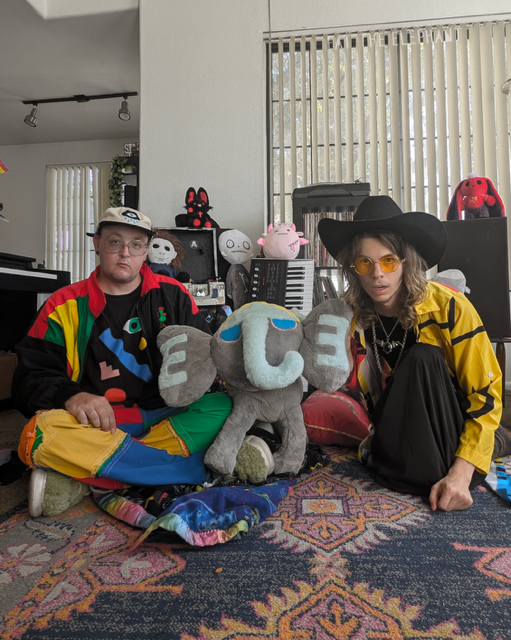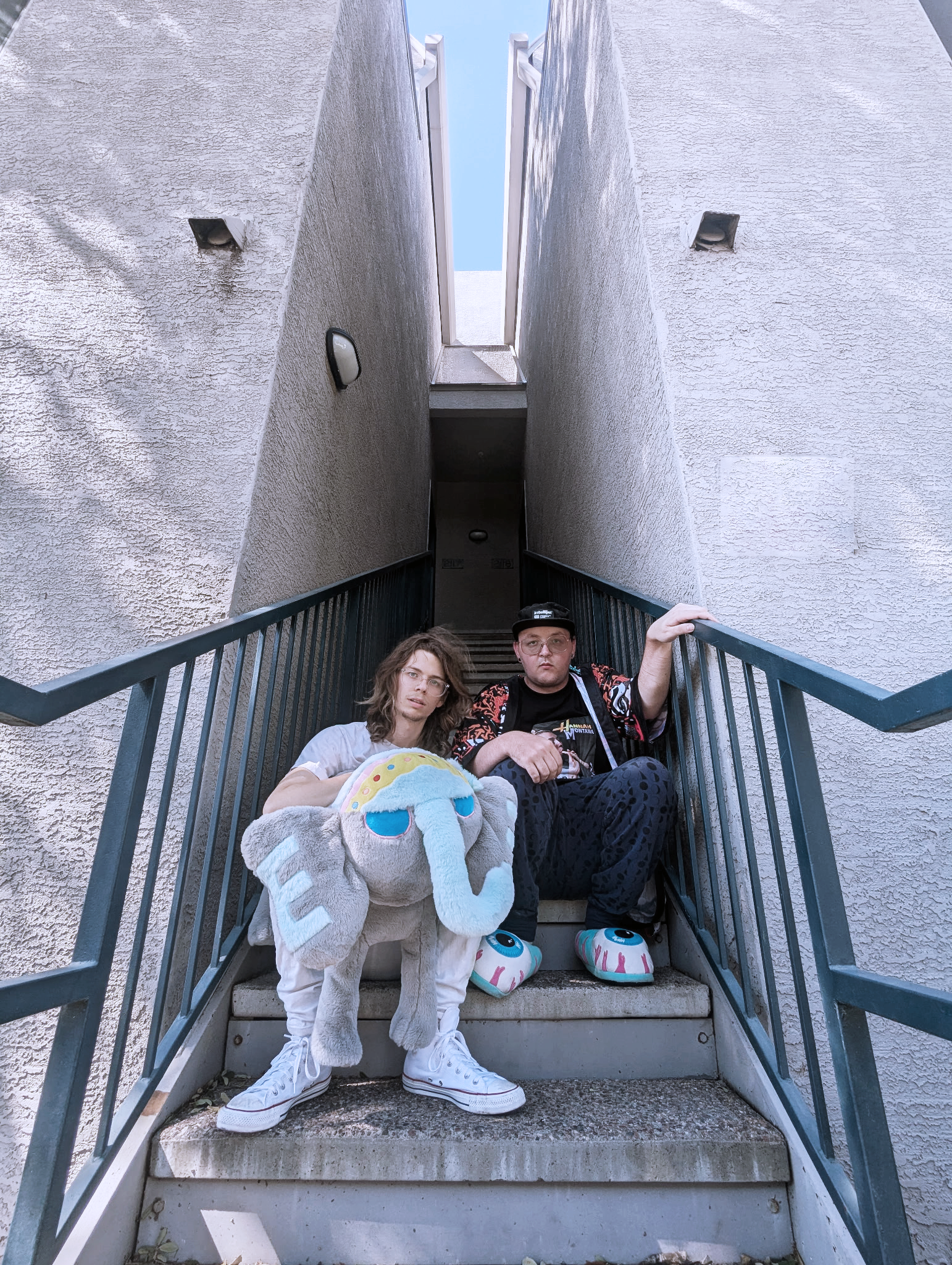Artist Spotlight: Eat the Elephant
Introduction
In our very first Artist Spotlight, we’re interviewing Eat the Elephant! This is the start of a new series of posts where we get to know the artists who perform at Mesa Synth. Let’s get into the interview!
Can you tell us a bit about yourself and the kind of music you create?
Eat the Elephant is an experimental music project combining the minds of Jakob Maloney and Benjamin Rosfeld, who met at the Mesa Synth “Synth and Sip” in December 2024. Since then, we have been combining our talents to create new kinds of songs and sonic experiences that we feel we haven’t heard before. Our music dabbles in many different genres that we’ve both been influenced by, but is made cohesive by strong vision, curiosity in the unknown, and adventurous spirit.
What first drew you to synthesizers? Do you remember any early moments that sparked your interest?
Jakob:
I had been playing guitar / bass / singing for some years and early into high school I was at a friends house hanging out and potentially in a mind-altered state. That’s when I heard Infected Mushroom for the first time. I went home and googled what kind of guitar pedals they used (ignorant), and I fell into deep research about DAWS, soft synths, a whole new world of making music. I went on craigslist and found someone selling cracked copies of Reason (A daw) for $40 and my mom drove me to meet a guy at a gas station to buy it. Over time I learned reason and the soft synths inside of it, this eventually led me to learning logic and eventually Ableton, which is still my sonic home to this day.
In my earlier years in daws, I was primarily making moombahton, drum and bass, dubstep, House (overall bass music). I spent many years using Ableton pretty much all day everyday (benefits of online high-school) and going to trade school for synthesis / electronic composition / sound design after high school. I got certified in Ableton, Logic and Pro Tools, as well as FMOD (Developing sound for video games). This led to working as an Ableton teacher for a while, A ‘ghost’ producer for a production house, overall electronic production work like mixing / mastering and making sample / synth preset packs. When I was 19 I started releasing electronic dance music (heavily synth driven music) under the alias Jameston Thieves, which made synthesizers my main avenue of expression. I ended up doing a fair amount of touring over some years and releasing on some sizable labels like Atlantic, Interscope and OWSLA. Along with opportunities to create official remixes for artists like Diplo, Tommy Lee, Papa Roach and Flo Rida.
After some time of being totally ’in the box’ non-stop, I craved the feeling of jamming / spontaneity I used to get when I was younger playing with bands. So about 9 years ago I acquired a doepfer low cost case, Mutable instruments Braids, Clouds, Veils, Ripples, and a befaco radio module. I loved being able to literally touch sound and it led to a decade of building a pretty sizable modular rig. Today, I use my modular largely in conjunction with Ableton and some other pieces of gear. I still love creating sounds with software from time to time, I think Serum 3 is absolutely bonkers, as is PhasePlant and the entire Kilohearts environment. I also think Ableton itself is an absolute sound designers paradise. Along with VCV rack! When I’m in public and have my EarPods I’ll often sneak a patch in on the MiRack app for iPhone / iPad (These days you can patch anywhere! And that’s epic)
So yeah, for the majority of my life, synths have been a massive part of it in every way, some may call it an obsession and I’d agree. The quest for timbre is my ultimate love.
Ben:
My musical upbringing was very classical-music focused, but my dad is an audio engineer, and built his own studio (that he runs to this day) while I was growing up. When I was about 10 or 11, he started letting me play around with the synthesizers he owned; these were mostly analog keyboard synths and the earliest version of the Arturia V-Collection. I made a number of wacky electronic tracks, and really couldn’t stop after that. Furthermore, hearing Jean Michael Jarre, Wendy Carlos, and Kraftwerk at a young age really solidified the fact that I wanted to make electronic music for the rest of my life, and I was also really influenced by the soundtrack to Minecraft, which I played a lot growing up. When I was about 15, I started building modular synths from DIY kits, and really learned a lot about sound design from doing that, but that evolved into a collection of modular gear (some of which was inherited) that I still use today to create wacky noises and soundscapes.
Do you have a favorite piece of gear or software in your setup? What makes it special to you?
Jakob:
I have to say my FAVORITE piece of gear to use is my modular system. I see it as one big eco-system capable of so many approaches. It started as a noise box, it still is a noise box, but I have also gone through periods of taking more musical approaches to my setup, more live performance based approaches, hybrid approaches involving computers, musique concréte, you name it, I’ve probably tried to make it work with my modular. As you can imagine, many modules went into actualizing these different phases, so I’ve nicknamed my system the Quantum Computer. I have to give an honorable mention to Ableton as my software pick though, it’s absolutely the most crucial piece of equipment for me to create music. Every project I have from Eat the Elephant, Varuna Ghat, Jameston Thieves is heavily sequenced, arranged, mangled and influenced by Ableton and the tools within it.
Ben:
My favorite piece of gear is probably my modular synth. Most of it exists in a briefcase and was left to me by my mentor, the late great Jeff Boydstun, after he passed. Not only do I feel it creatively suits me and the kind of music I make, but I also feel like I carry a piece of Jeff with me wherever I have it, and playing it feels like I’m conveying his soul to living.”
What does your creative process usually look like when you’re starting a new track or live set?
Our creative process usually comes from taking an amalgamation of many ideas that we call “paint splatter,” and then organizing those splatters into something cohesive thematically and sonically. We both practice a philosophy of putting out a lot of ideas, but never staying rigidly attached to them, allowing them to become living beings we feed, care for, and foster into something that transcends both of us.
Where can people hear more of your work or follow what you’re doing?
We are releasing our first single “Tears of a Dove” under Eat the Elephant on all streaming platforms, and can be found on social media at @eat.the_elephant


